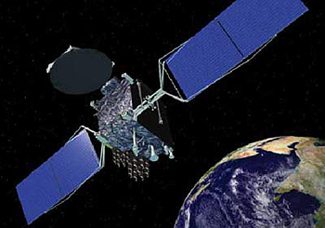Rogue Satellite Won't Die

Galaxy 15
The mainstream press has finally picked up on the failure of Galaxy 15 that was first covered in RF Report almost a month ago. While those stories focused on the impact Galaxy 15 transponders will have on AMC-11 satellite, the popular press articles are short on technical details. AMC-11 is home to popular cable nets Lifetime, Food Network, HGTV, A&E, MTV, Nickelodeon, BBC America and more.
Will these popular channels disappear from cable channels when Galaxy 15 moves into AMC-11's location? Perhaps not. After all, you didn't see a major disruption of the cable networks at 133 degrees west longitude.when traffic was moved from Galaxy 15 to Galaxy 12. The 133 degree location is home to many cable feeds, including Turner networks, HBO, and NBC networks USA, Syfy, Sleuth and Oxygen. I'll explain how after a little history.
When Galaxy 15 was in between Galaxy 12 and AMC 11, Intelsat and Orbital Sciences engineers tried to regain control of it. When that failed, they had to take more drastic measures. Uplink operators know they have to be in contact with the satellite operator and gradually increase power when transmitting to a satellite. The fear is that if there is too much power, not only will it cause interference to other users but it could damage the power amplifiers in the satellite. As I suspected they would do, it appears Intelsat attempted to kill Galaxy 15 by transmitting strong signals and overloading its power circuits. Unfortunately, the protection circuits worked better than the telemetry, tracking and telecommand (TT&C) payload. This attempt required careful coordination between Intelsat and SES New Skies, the owner of AMC-11 to avoid interfering with AMC-11.
Intelsat is posting data on Galaxy 15's movement towards AMC-11. Go to Intelsat Owned/Operated Satellites Ephemeris Data and scroll down to "Galaxy Region (W)". Using the dropdown menus, select "Galaxy 15" to view the data. The "Center of Box" has the predicted location of the satellite for the next two weeks. According to the May 11 prediction, Galaxy 15 will be within 0.5 degree of 131 degrees west longitude around 17:00 UTC on May 24.
Many cable downlinks operate with antennas as small as 4.5m. At this size, the –3 dB beamwidth is around 1.3 degrees. In less than two weeks Galaxy 15 will be sitting in the main beam of these antennas. Will Food Network be toast when this happens? Perhaps not!
Two things could help viewers of programs on AMC 11. First, Galaxy 15 is not tumbling through space. Its transponders are cross-polarized with AMC 11. This helps in both directions – uplinks aimed at AMC 11 will put less signal into Galaxy 15 and Galaxy 15 signals will be attenuated at downlinks polarized for AMC 11. Because adjacent transponders overlap, this won't completely eliminate interference. The best hope of Intelsat and SES New Skies may be the size of the uplink dishes used to access these cable satellites. For example, a Vertex 9m C-band uplink dish has a –3 dB beamwidth of 0.36 and a –15 dB beamwidth of 0.76 degrees. Up the dish size to 11.1 meters and the beamwidth is even smaller –0.28 degrees at –15 dB. As long as AMC 11 can stay 0.5 degrees or so away from Galaxy 15, the amount of energy hitting Galaxy 15 and, as a result, the amount of interference from Galaxy 15 to AMC-11 downlinks, will be greatly reduced. Operating a satellite this far out of its normal 0.1 degree box will require FCC approval.
Keeping MTV viewers happy will require a celestial dance of the satellites; SES New Skies will need to move AMC 11 around Galaxy 15, maintaining enough distance from it for uplinks to minimize the signal into Galaxy 15 while staying close enough to 131 degrees west longitude so cable operators don't have to adjust their antennas to follow it. Engineers at uplinks looking at AMC 11 will be busy, as they will need to move their uplink dishes to follow AMC 11 as it dances around Galaxy 15. Other steps SES New Skies could take to minimize interference would be to have uplinks lower power so they can remove attenuators from the transponder input, further reducing the amount of signal into Galaxy 15. Will they be able to pull it off? I think there is a good chance they will. The cable nets have a big incentive to make it work!
If you are uplinking or downlinking AMC 11 signals, drop me a note in two weeks and let me know how its is working.
The professional video industry's #1 source for news, trends and product and tech information. Sign up below.

Doug Lung is one of America's foremost authorities on broadcast RF technology. As vice president of Broadcast Technology for NBCUniversal Local, H. Douglas Lung leads NBC and Telemundo-owned stations’ RF and transmission affairs, including microwave, radars, satellite uplinks, and FCC technical filings. Beginning his career in 1976 at KSCI in Los Angeles, Lung has nearly 50 years of experience in broadcast television engineering. Beginning in 1985, he led the engineering department for what was to become the Telemundo network and station group, assisting in the design, construction and installation of the company’s broadcast and cable facilities. Other projects include work on the launch of Hawaii’s first UHF TV station, the rollout and testing of the ATSC mobile-handheld standard, and software development related to the incentive auction TV spectrum repack. A longtime columnist for TV Technology, Doug is also a regular contributor to IEEE Broadcast Technology. He is the recipient of the 2023 NAB Television Engineering Award. He also received a Tech Leadership Award from TV Tech publisher Future plc in 2021 and is a member of the IEEE Broadcast Technology Society and the Society of Broadcast Engineers.
